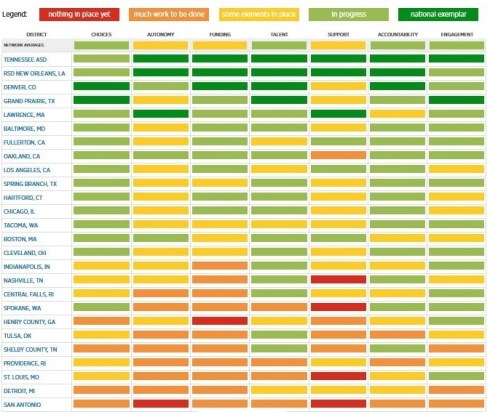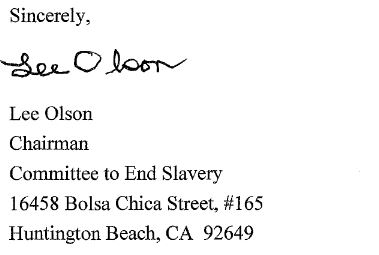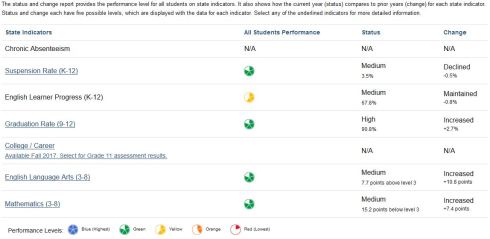By Thomas Ultican 12/15/2017
Three researchers from Indiana coined the terminology Destroy Public Education (DPE). They refuse to call it reform which is a positive sounding term that obfuscates the damage being done. America’s public education system is an unmitigated success story, yet, DPE forces say we need to change its governance and monetize it.
We are discussing the education system that put a man on the moon, developed the greatest economy the world has ever seen and wiped out small pox. It is the system that embraces all comers and resists all forms of discrimination. In the 1980’s, it was laying the foundation for the digital revolution when it came under spurious attack.
Not only are great resources being squandered on DPE efforts but the teaching profession is being diminished. Organizations like Relay Graduate School and the New Teachers Project are put forward as having more expertise in teacher education than our great public universities. That would be amusing if wealthy elites were not paying to have these posers taken seriously.
The DPE Model Playing Out in Indianapolis
The researchers from Indiana who defined the DPE model are Gail Cosby, Nate Williams and Jim Scheurich. In 2012, Doctor Scheurich came to Indiana from Texas A&M to coordinate the Urban Education Studies doctoral program at the University of Indiana Purdue University Indianapolis (UIPUI). Gail Cosby is a former public-school teacher, a former school board member who won her seat in 2012 with DPE help and is presently in her second year of doctoral studies at UIPUI. Dr. Nate Williams received his doctorate in Urban Education Studies at UIPUI and is now teaching at Knox College.
Soon after becoming a school board member, Cosby realized the true nature of her benefactors and became an outspoken critic of the DPE agenda. While closely observing the events transpiring around Indianapolis public schools Cosby, Scheurich and Williams perceived a model for the destruction of public education. They believe that same model is being used throughout the nation.
Here are the key model components paraphrased from their work which Diane Ravitch posted:
- Business is the best model for schools.
- A local-national collaboration between wealthy conservatives. (Sometimes far right)
- Huge infusion of new dollars into school board elections. (Dark Money)
- Unified enrollment.
- Teach for America (or any instant-teacher-certification program) and groups like Teach Plus controlling professional development of teachers.
- Innovations Schools. An ALEC sponsored charter conversion model.
- A funding conduit for national-local wealthy individuals and organizations to support local DPE initiatives.
- Integration of charter schools into traditional public schools with rules favoring charter schools.
- Developing networks of local organizations or affiliates that collaborate on the agenda.
- Support for gentrification.
In Indianapolis, the big bopper is the Lilly Endowment. It has a total asset value of more than $10 billion making it three times larger than the Walton Family Foundation. The Lilly Endowment, which was established by Eli Lilly in 1937, presented grants totaling $458,522,495 in 2015. Of this total more than half went to Christian causes. As the endowment states, “The ultimate aim of Lilly Endowment’s religion grantmaking is to deepen and enrich the religious lives of American Christians, primarily by helping to strengthen their congregations.”
However, they also spend significant amounts of money on DPE efforts. Their education web-page lists the endowment’s partners in what amounts to the effort to destroy public education in Indianapolis. That list includes:
The Mind Trust – www.themindtrust.org
Teach for America – www.teachforamerica.org
The New Teacher Project – www.tntp.org
Lilly’s DPE grants in 2015 encompass:
- Center for Leadership Development which includes the College Prep Institute $1,385,150
- CICP Foundation a local business group supporting tech and DPE $17,000,518
- Eleven Fifty Academy Inc. a feasibility study $50,000
- The Mind Trust, the key local DPE leadership $7,170,000
- Pacific Research Institute Pacific Research Institute a DPE oriented conservative think tank in California $175,000
- Regional Opportunities Initiatives promotes local development and DPE style control of teachers and curriculum in rural Indiana $25,870,000
- Segamore Inst. A local think tank that provides scholarships for education choice $302,100.
- University of Indianapolis Methodist founded University that is partnered with The Mind Trust in the Indianapolis DPE program $1,698,477.
Teach for America, The New Teacher Project and Teach Plus support DPE efforts to control teacher professional development and curriculum. The Mind Trust and Stand for Children function as money conduits for privatizing schools, lobbying state legislators and winning school board elections. All these organizations are operating in Indianapolis but most of their funding comes from outside sources. A very incomplete search revealed:
- The Mind Trust Years 2011-1012 $539,334 + $1,420,000 = $1,959,334
- Teach for America lists 97 entries the first 10 grants total more than $10,000,000
- Stand for Children 111 entries fist grant listed was for $4,311,641
- Relay Graduate School $8,954,644
- Relay plus four other similar programs $34,700,000
- Charter Fund the 1st of 302 entries was for $27,000,000
- New Teacher Project Inc. in 2015 a total of $17,494,372
- CEE Trust which is now SchoolSmart $1,250,000
- Teach Plus total $19,094,388
- Charter Fund $6,638,000
- Mind Trust $650,000
- Stand for Children $350,000
- Students First $1,250,000
- Teach for America $22,019,240
- Friedman Foundation for Education Choice In. $624,500
- Relay Graduate School $1,500,000
- Teach Plus $250,000 2013 and $250,000 2014
- Stand for Children $250,000
- Students First $750,000
- Teach for America $612,000
- Charter Fund $350,000
- Teach Plus $165,000
- Charter Fund $10,000,000
- Indianapolis Public Schools Education Foundation, Inc. $1,256,250
- Kipp Foundation $10,000,000
- Relay Graduate School $2,500,000
- Stand for Children $6,640,000
- Student First $7,850,000
- Teach for America $9,482,369
- The Mind Trust $11,075,000
- The New Teachers Project $8,136,464
Both Stand for Children and Betsy DeVos’s American Federation for Children operate associated 501 C4 organizations. This means that instead of being a tax-exempt foundation operating under IRS section 501 C3 rules which limit political spending the C4s are not tax exempt and can spend directly on politics. What is even better for them is that they don’t have to reveal where they got the money. This kind of spending is known as dark money.
Betsy DeVos, then chairman of American Federation for Children did send DPE targeted funds to Indianapolis from the tax-free fund. Don’t know how much the C4 sent. The last form 990 filed by the C3 was in 2015. It showed:
- Indianapolis Urban League for outreach $36,000
- Institute for Quality Education Indianapolis $310,000
- Network for Quality Education Indianapolis for strategic plan $100,000
Dylan McCoy of Chalk Beat Indiana reporting on the 2016 school board elections used a board seat in a small district with 11,000 students to illustrate the effect outside money is having. He wrote:
“In a district where candidates typically spend less than $10,000 on even the most competitive races, Deitric Hall, a local teacher, has raised more than $32,000. Nearly all that money is from a single political action committee: Leadership for Educational Equity, a Washington D.C.-based PAC that supports Teach for America alumni running for public office.
“It’s a small-scale version of a phenomenon that has played out in urban districts around the country as outside campaign contributions have increasingly influenced pivotal school board races. In Indianapolis Public Schools, outside contributions helped radically reshape the board in 2012 and 2014, when out-of-state funders backed a victory for charter-school supporters.”
An article in the Indystar about this situation says,
“Local democratic control of IPS schools by ordinary folks no longer exists. First, big outsider money has united with big insider money to make the cost of school board member elections far beyond the reach of ordinary folks. Second, a linked group of “local” “reform” organizations, funded largely by the same outsider-insider big money, are controlling IPS.”
Diane Ravitch summed it up:
“The business community, civic leaders, political leaders, DFER, the Mind Trust, and Stand for Children have joined together to Destroy Public Education. As they attack democratic institutions, they falsely claim that “it is all about the kids” and they claim they are advancing civil rights. Instead, it is about money and power and gentrification.”
Indiana has adopted Jeb Bush’s plan for grading schools with an A-F scheme. This plan is based almost exclusively on standardized testing which has zero ability to evaluate school or teacher quality. In addition, with the DPE forces pulling the strings, Indiana made it possible for Mind Trust to claim that six of seven Innovation schools in the Indianapolis public school system went from D and F grades to A and B grades in their first year.
The spectacular results are a ruse facilitated by having the option to use growth data instead of performance data. The scores for the schools are horrible. Gail Cosby shared the results:
“Let’s take a look at the actual percentages of students PASSING BOTH MATH AND ELA:
- Cold Spring: 2%
- Enlace: 28.0%
- Global Prep: no data
- Phalen 103: 8%
- Phalen 93: 38.2%
- Kipp Indy: 18.0%
- Kindezi: no data”
DPE Model is Materializing Across the Country
Another plan for destroying public education comes from The Gates funded Center for Reinventing Public Education (CRPE) at the University of Washington. It is called the portfolio model. The National Education Policy Center describes the portfolio model:
“Generally speaking, four reform strategies are combined, in varying degrees, in portfolio districts: (1) performance-based (generally test-based) accountability, (2) school-level de-centralization of management, (3) the reconstitution or closing of “failing” schools, and (4) the expansion of choice, primarily through charter schools.”
CRPE has produced a chart based on the implementation of the portfolio model. This chart is in effect a limited outline of the DPE movement in the United States.

A Screen Grab from Portfolio Model Implementation by CRPE at University of Washington
Another example of the DPE model in action comes from Kansas City, Missouri. Two giant foundations – The Ewing Marion Kaufman Foundation (nearly $2 billion in assets) and the Hall Family Foundation (nearly $1 billion in assets) are the big local funders.
The late Ewing Kaufman is the businessman hero who brought major league baseball back to Kansas City. His fund spends a lot of money on business analytics and developing entrepreneurship. They also have started their own charter schools, are funding several other charter schools and are contributing to the national DPE movement.
Some Kaufman Foundation Reported Spending, 2015-990.
- Ewing Marion Kaufman Schools Inc. and School Buildings $12,527,932
- KIPP Foundation $200,000
- Teach for America $577,500
- Leading Educators Inc. $100,000
- The Third Way Foundation $75,000
- Relay Graduate School of Education $135,000
- New Schools for New Orleans $20,000
- Data Quality Campaign $965,895
- WestEd $258,694
- IFF One North La Salle St Chicago – education facilities access $5,100,000
- National Council on Teacher Quality $134,658
- Bellwether Education Partners Inc. $87,951
- Kansas City School district to support STEM and IB $25,235
- Kansas City School District for expansion of New America’s Academy at Gladstone Elementary School $150,000
- Kansas City School district to support charter school liaison position $25,000
- City of KC, Mo. for adviser to Mayor on Ed Policy $50,000
- The Lean Lab to promote education entrepreneurs $50,000
- SRI International to advance STEM studies $93,670
- Bishop Ward School $170,000
- Various other Charter Schools $1,325,000
As listed above, the local school district did get three relatively small grants from the Kaufman foundation; two to implement charter schools in the district and one to promote the fraudulent STEM program and move curricular development out of Kansas City to the International Baccalaureate program.
Some Hall Foundation reported spending, 2015-990.
- Plaza Academy (private school) $50,000
- Academe Lafayette $550,000
- Citizens of the World Charter School $650,000
- Cristo Rey Kansas City high school private catholic $50,000
- Crossroads Academy of KC $275,000
- Leading Educators $452,207
- Missouri Charter Public School Association $50,000
- Prep-KC $523,671
- Science Pioneers Inc. (STEM Program) $50,000
- Teach for America – KC $1,013,000
Notice that Kansas City is not on the CRPE chart but DPE is certainly doing well there. Originally the DPE agenda was led by the Gates financed CEE Trust. That organization alienated residents. Now SchoolSmart KC is the new DPE leader and they have learned from the CEE Trust failure. Chalkbeat reports:
“SchoolSmart has carved out its own niche by backing community schools, while also embracing much of what is known as the “portfolio” model for managing schools. The idea — including common enrollment and accountability systems for district and charter schools — has gained traction in a number of cities nationwide as a growing network of well-heeled groups like SchoolSmart are pushing for districts to adopt this approach.
“Kansas City is a case study in how that vision is being advanced city by city — and why some national groups that continue to fund and support the approach have taken a backseat in favor of local actors.”
Conclusion
DPE marketing has gotten better and it definitely has huge money fueling it. However, they are selling an inferior product. That is why more than 90% of America’s students remain in public schools run be elected boards. We must protect those boards from being defiled by monied elites and save our schools.
Twitter: @tultican











Recent Comments